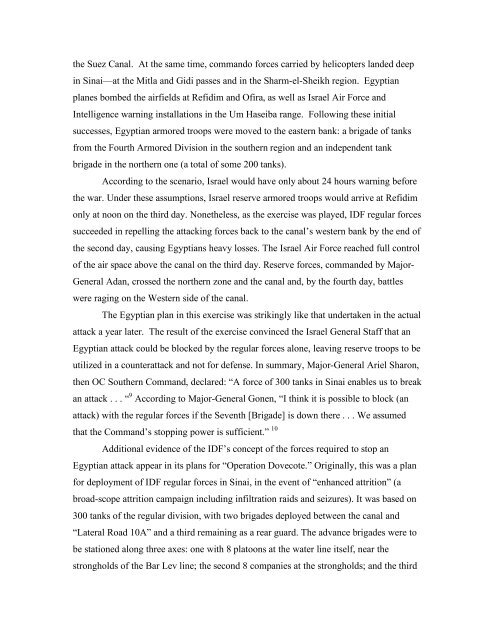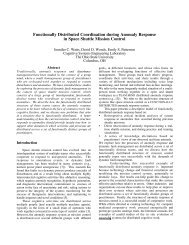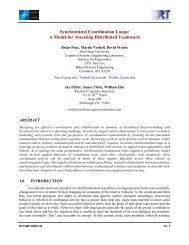Fundamental Surprises Zvi Lanir Decision Research 1201 Oak ...
Fundamental Surprises Zvi Lanir Decision Research 1201 Oak ...
Fundamental Surprises Zvi Lanir Decision Research 1201 Oak ...
- No tags were found...
You also want an ePaper? Increase the reach of your titles
YUMPU automatically turns print PDFs into web optimized ePapers that Google loves.
the Suez Canal. At the same time, commando forces carried by helicopters landed deep<br />
in Sinai—at the Mitla and Gidi passes and in the Sharm-el-Sheikh region. Egyptian<br />
planes bombed the airfields at Refidim and Ofira, as well as Israel Air Force and<br />
Intelligence warning installations in the Um Haseiba range. Following these initial<br />
successes, Egyptian armored troops were moved to the eastern bank: a brigade of tanks<br />
from the Fourth Armored Division in the southern region and an independent tank<br />
brigade in the northern one (a total of some 200 tanks).<br />
According to the scenario, Israel would have only about 24 hours warning before<br />
the war. Under these assumptions, Israel reserve armored troops would arrive at Refidim<br />
only at noon on the third day. Nonetheless, as the exercise was played, IDF regular forces<br />
succeeded in repelling the attacking forces back to the canal’s western bank by the end of<br />
the second day, causing Egyptians heavy losses. The Israel Air Force reached full control<br />
of the air space above the canal on the third day. Reserve forces, commanded by Major-<br />
General Adan, crossed the northern zone and the canal and, by the fourth day, battles<br />
were raging on the Western side of the canal.<br />
The Egyptian plan in this exercise was strikingly like that undertaken in the actual<br />
attack a year later. The result of the exercise convinced the Israel General Staff that an<br />
Egyptian attack could be blocked by the regular forces alone, leaving reserve troops to be<br />
utilized in a counterattack and not for defense. In summary, Major-General Ariel Sharon,<br />
then OC Southern Command, declared: “A force of 300 tanks in Sinai enables us to break<br />
an attack . . . “ 9 According to Major-General Gonen, “I think it is possible to block (an<br />
attack) with the regular forces if the Seventh [Brigade] is down there . . . We assumed<br />
that the Command’s stopping power is sufficient.” 10<br />
Additional evidence of the IDF’s concept of the forces required to stop an<br />
Egyptian attack appear in its plans for “Operation Dovecote.” Originally, this was a plan<br />
for deployment of IDF regular forces in Sinai, in the event of “enhanced attrition” (a<br />
broad-scope attrition campaign including infiltration raids and seizures). It was based on<br />
300 tanks of the regular division, with two brigades deployed between the canal and<br />
“Lateral Road 10A” and a third remaining as a rear guard. The advance brigades were to<br />
be stationed along three axes: one with 8 platoons at the water line itself, near the<br />
strongholds of the Bar Lev line; the second 8 companies at the strongholds; and the third









